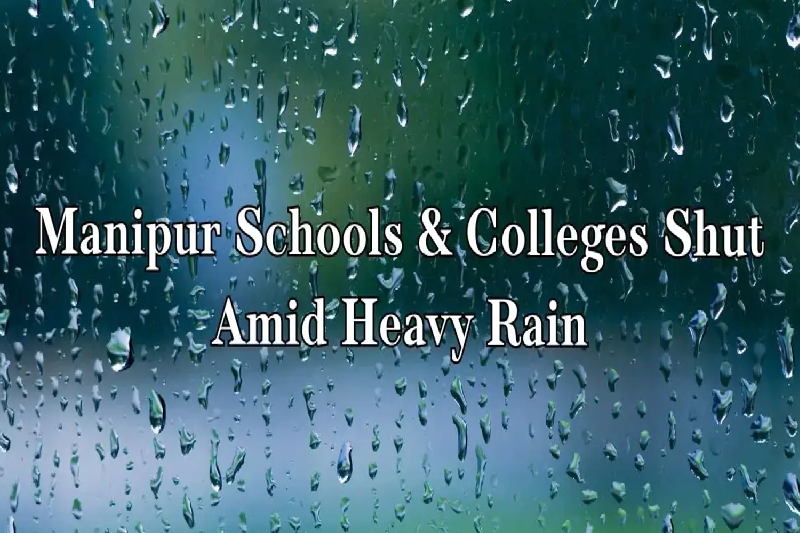
Manipur Shuts Schools and Colleges as Heavy Rains Trigger Floods, Evacuations, and Infrastructure Damage
Manipur is reeling from incessant rains and severe flooding that have forced the closure of all educational institutions across the state. On September 17, 2025, the government ordered schools, colleges, and universities to remain shut for student and staff safety as the Indian Meteorological Department (IMD) forecast more rainfall over the next 48 hours. With rivers breaching embankments, homes submerged, and critical infrastructure destroyed, authorities remain on high alert as the crisis deepens.
Educational Institutions Closed Statewide
The Directorate of University and Higher Education and the Directorate of Education (School) jointly announced the closure of all government, private, and aided institutions. The order covers the entire state, including the flood-affected Imphal Valley, Imphal East, and Thoubal districts. Officials stated that the step was necessary to protect students, teachers, and staff as water levels continue rising, creating the risk of floods and landslides.
Rivers Breach Embankments, Inundating Communities
The crisis escalated as two major rivers — Iril and Wangjing Rivers — breached their embankments.
- At Kshetrigao in Imphal East, the overflowing Iril River inundated vast farmland, homes, and roadways.
- In Thoubal district, the Wangjing River crossed danger levels, flooding Sangaiyumpham and Wangjing areas and submerging residents and villages.
Officials reported widespread agricultural damage, destroying paddy fields, livestock, and local markets. Transportation has been severely hampered, and residents are struggling with food shortages, lack of clean water, and disrupted connectivity.
Rescue Operations and Relief Measures
Emergency services have been deployed on a large scale. Manipur Fire and Emergency Services teams are actively conducting rescue operations in Imphal East, moving affected families to temporary relief centres such as Yairipok Khoirom Mayai Leikai.
However, relief efforts have faced challenges. The waterlogged Wangjing Kodompokpi Sports Complex, converted into a relief camp, complicates aid distribution. Residents have expressed concerns over inadequate shelter and medical supplies, with many displaced families awaiting assistance.
Infrastructure Collapse and Connectivity Loss
The floods have severely damaged the state’s infrastructure. A crucial iron bridge over the Thoubal River at Yairipok was swept away by surging waters, cutting off connectivity to several villages and localities in Imphal East and Thoubal districts.
Authorities warn that rebuilding efforts may take considerable time, given the scale of destruction and continuous rainfall. Roads across districts are submerged or destroyed, making it difficult for relief teams to access the worst-hit areas.
Medical Crisis at JNIMS Hospital
The situation turned critical at the Jawaharlal Nehru Institute of Medical Sciences (JNIMS), Imphal. Rising water levels around the hospital prompted Medical Superintendent Lokeshwar Singh, with approval from higher authorities, to issue an urgent evacuation order.
All inpatients have been moved out of the facility, and the hospital has suspended new admissions until further notice. This has placed immense pressure on healthcare services in the region, leaving many without immediate access to treatment. Officials fear waterborne diseases could increase as sanitation facilities are overwhelmed.
Nagaland Also Reports Widespread Damage
The crisis is not confined to Manipur alone. Neighboring Nagaland has reported similar devastation due to continuous rainfall between September 8 and 14. According to the Nagaland State Disaster Management Authority (NSDMA), multiple districts have witnessed the destruction of:
- Roads and bridges
- Homes and public buildings
- Agricultural land and cropland
In addition, landslides have been reported in several regions, worsening mobility and increasing risks to residents and relief workers.
IMD Forecast: More Rain Ahead
According to the IMD, heavy rainfall will continue for the next 48 hours, raising fears that the situation may deteriorate further. Officials caution that more flooding, landslides, and infrastructure collapse are possible if rainfall intensity does not ease. Relief and rescue teams remain stationed across vulnerable areas, and the government has urged residents to remain cautious and follow safety advisories.
Authorities on High Alert
State authorities, disaster management teams, and local administration closely monitor the situation. Efforts are underway to:
- Relocate displaced families to safer shelters
- Provide food, water, and medical assistance.
- Repair damaged infrastructure wherever possible.e
However, challenges remain significant with key relief camps flooded and critical infrastructure cut off. Local communities are urged to cooperate with emergency services and avoid travel through inundated areas.
Conclusion: A Humanitarian and Infrastructural Crisis
The floods in Manipur have brought life to a standstill — displacing families, shutting down schools and colleges, destroying infrastructure, and straining healthcare facilities. The closure of educational institutions reflects the gravity of the crisis, as the state prioritises the safety of its students and staff.
With forecasts of further rainfall, both Manipur and Nagaland remain on high alert, facing a disaster that highlights the urgent need for robust flood management, resilient infrastructure, and coordinated disaster response systems. For now, the people of Manipur await relief and recovery while bracing for more challenges in the days ahead.


